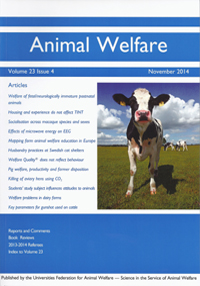Document type: scientific article published in Animal Welfare
Authors: G.V. Berteselli, S. Messori, L. Arena, L. Smith, P. Dalla Villa, F. de Massis
Preview: The European regulatory framework lacks standardisation as regards the minimum requirements for shelter facilities, making defining welfare standards for dogs challenging. Dog(Canis familiaris) welfare assessments should consist of a comprehensive set of measurements that allow the calculation of an overall 'welfare score. The Shelter Quality protocol was developed for the purpose of assessing shelter dog welfare. The study aims to establish a standardised system for evaluating shelter dog welfare by obtaining agreement from experts on the weighting of different measures contributing to an overall welfare score. The Delphi technique is a widely used method for establishing consensus among experts. Two Delphi procedures were implemented and we compared their effectiveness in achieving expert consensus by evaluating rounds' numbers required to reach consensus and the response and attrition rates. Expert consensus was achieved in Delphi 1 when the standard deviation in the expert weightings was ≤ 5. This was achieved easily for the welfare score weightings of the four principles: 'Good feeding', 'Good housing', 'Good Health', and 'Appropriate behaviour.' Animal-based measures were found to reach consensus more quickly than resource-based measures. In Delphi 2, we used the coefficient of variation to determine consensus. No statistical differences were found between the two Delphi methods for attrition rate, response rate or number of participants. Continuing rounds until a consensus is reached is recommended as this method balances time and participant fatigue. A standardised scoring system is provided, using a single overall score of welfare that can be used to compare welfare standards between shelters.






